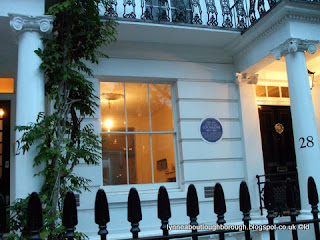So, the architect William Railton built St Paul's Church at Woodhouse Eaves - amongst others - and was also responsible for the Bavarian Gates on the Garendon Estate, and Beaumanor Hall, the Herrick residence. I've posted about this before:
http://lynneaboutloughborough.blogspot.co.uk/2016/03/william-railtons-bavarian-gates.html
and
http://lynneaboutloughborough.blogspot.co.uk/2015/10/walk-from-loughborough-to-beaumanor.html
It appears that Railton, who lived in London, was brought to the county of Leicestershire by Ambrose Lisle March Phillipps de Lisle, who had great plans to bring Catholicism back to the county. Having designed and created a home for De Lisle at Grace Dieu (which was altered in 1837 and updated in 1847 by Augustus Welby Northmore Pugin), Railton was then commissioned to design the original Mount St Bernard's Abbey and this was followed by two lodges and a house on Garendon Park.
The folk engaged to build the abbey at Mount St Bernard were Irish Catholics, and because they settled in Whitwick, De Lisle paid for the building of a small chapel (Holy Cross Church, now demolished and rebuilt on the other side of the road) and later a presbytery (still standing and now a listed building), and engaged the services of Augustus Welby Northmore Pugin, architect.
From about 1875 the presbytery was used by Rosminian nuns who eventually transferred to the Convent in Loughborough, which had been created around 1841 when Lady Mary Anne Arundel, born Mary Anne Nugent-Temple-Grenville, and widow of James Everard tenth Lord Arundel of Warder, opened a small girls' school in Loughborough on Paget land.
In 1844 Sisters Mary Parea and Mary Somonini took over the running of the school, and Lady Mary died the next year, following a two-day illness. She was buried in the cloisters of what is now Ratcliffe College, despite her long-standing home having been Prior Park in Bath, now a National Trust property. Further buildings at the Loughborough Convent were designed by Charles Hansom, brother to Joseph Aloysius (prominent architect, but possibly more popularly known for the design of the Hansom cab), who was highly influenced by the works of Augustus Pugin.
Interestingly, Ratcliffe College was designed by Augustus Pugin, and the area known as The Square was designed by Charles Hansom. The Historic England listing for Ratcliffe College suggests that Augustus Pugin didn't finish the building, but that was done by Joseph Hansom, and that the chapel was created by Edward Welby Pugin, son of Augustus, in about 1875.
It doesn't appear that Edward Pugin created many buildings in Leicestershire, but he did create an 80 foot high tower, a monument to the son of Ambrose de Lisle, Everard Aloysius Lisle Phillipps VC, who was killed in the Indian Mutiny at Dehli in 1857. The tower was demolished in 1947 as it had become unstable. In 1865-6 Edward Pugin made various additions and changes to Garendon Hall.
As for the Hansoms, well, Joseph designed what is now New Walk Museum in Leicester, which was built in 1836 originally as a Nonconformist Proprietary School, and the Belvoir Street Baptist Chapel in Leicester, which is now home to the Vaughan College. At one time he lived in Hinckley, and was the architect for the Workhouse. I haven't been able to identify any further work by Joseph's brother, Charles in Leicestershire, although he has certainly designed some important buildings around the country, for example the Malvern College.
So, I think I'll end there, before I start rambling too far away from Loughborough.
 |
| Joseph Hansom's London House |
 |
| Beaumanor Hall Woodhouse |
You are welcome to quote passages from any of my posts, with appropriate credit. The correct citation for this looks as follow:
Dyer, Lynne (2018). A ramble around some Loughborough Connections. Available from: https://lynneaboutloughborough.blogspot.com/2018/01/a-ramble-around-some-loughborough.html [Accessed 14 January 2018]
Take down policy:
I post no pictures that are not my own, unless I have express permission so to do. All text is my own, and not copied from any other information sources, printed or electronic, unless identified and credited as such. If you find I have posted something in contravention of these statements, or if there are photographs of you which you would prefer not to be here, please contact me at the address listed on the About Me page, and I will remove these.
Thank you for reading this blog.
Lynne
No comments:
Post a Comment
If you have found this post interesting or have any questions about any of the information in it do please leave a comment below. In order to answer your question, I must publish your query here, and then respond to it here. If your information is private or sensitive, and you don't wish to have it on public display, it might be a better idea to email me using the address which is on the About Me page, using the usual substitutions: if you take the email route, our conversation remains private, and is not published on the blog. Thanks for reading the blog.